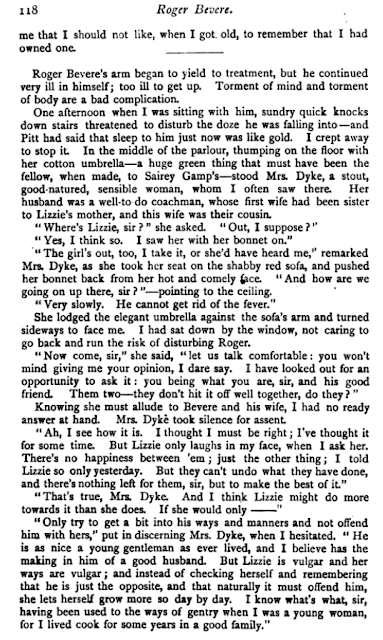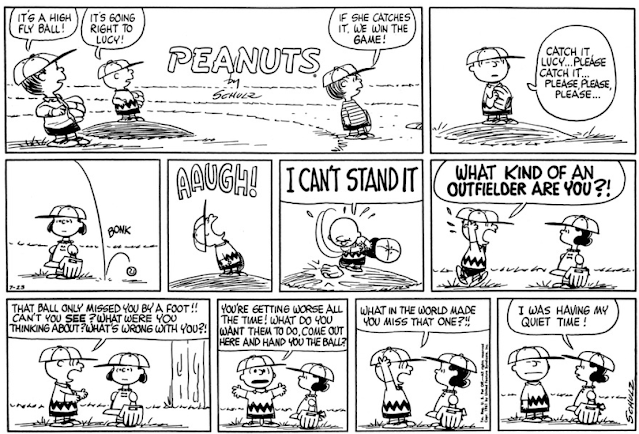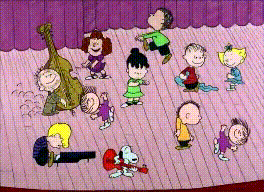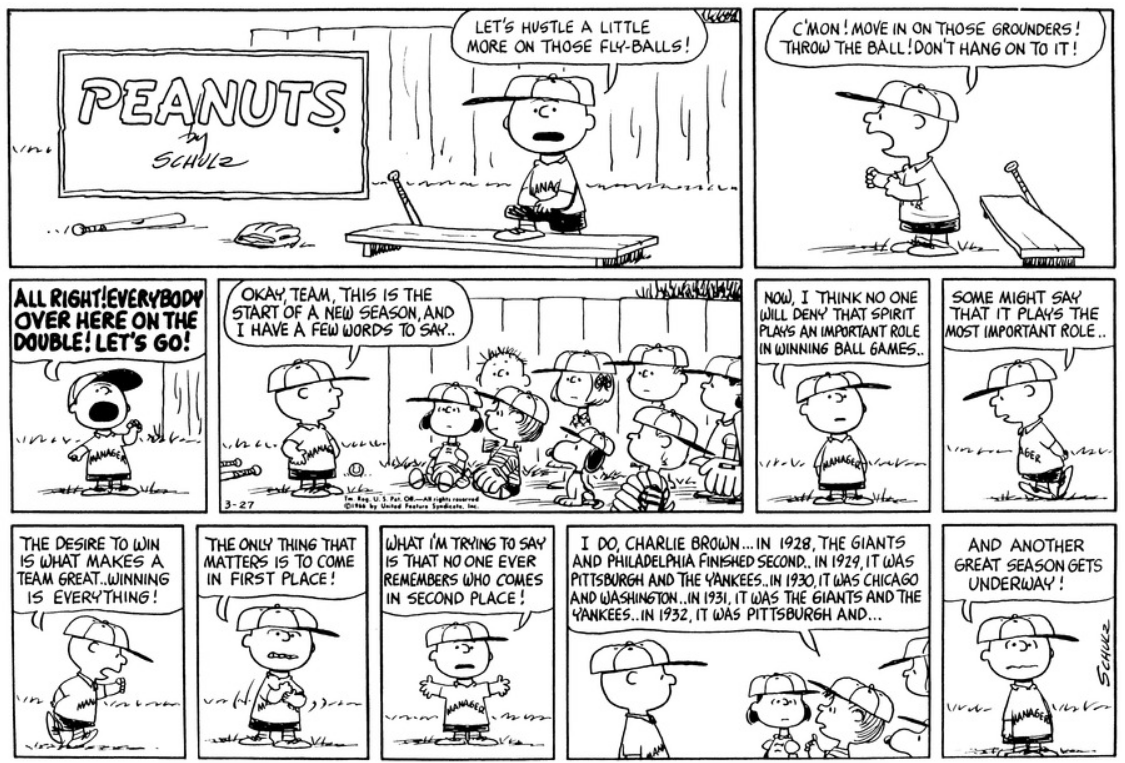I'm always pleased to see in my Blogger stats that someone has been looking at my analysis of how frequently characters appear in the Peanuts comic strip. You can check them out here if you're the kind of super-cool person who finds them interesting!
1950s
1960s
1970s
1980s
1990s
But let's talk about just one character today - the forgotten one who was there from the start but faded away long before the end. I'm talking, of course, about Shermy!
Shermy is one of the three characters who appear in the very first Peanuts strip. Indeed, he's the one who delivers all the dialogue!
It takes him a while to get a name, unlike Charlie Brown (who, like a lot of the earliest strips, is an echo of Charles Schulz's previous comic "Li'l Folks"), but Shermy is a central character for the first few months. Snoopy is just a dog who shows up now and then; back in October 1950 there's a series of strips that seem to suggest he belongs to Shermy.
But as the series develops, Charlie Brown becomes the central focus and Shermy starts to be seen less and less. New and more interesting characters appear - first Schroeder and then Linus make their debuts as babies but soon come to take over Shermy's role as a sidekick and straight man to Charlie Brown, Snoopy or the new big star Lucy. By the end of the fifties, we're really not seeing much of Shermy at all.
1960 might be Shermy's last year as any kind of regular presence in Peanuts - he appears in twelve strips that year - so let's start this story with 1961 and follow Peanuts through the rest of the decade. It's an important decade, because as well as the newspaper comics we got the debut of the animated cartoon specials! There were also comic books featuring original stories (as far as I can tell, poor Shermy never showed up in them) and other merchandise too - Peanuts was big business in the sixties! Except perhaps for the original star...
Here is what we see of Shermy in the sixties!
1 January 1961
We start the new year by showing Shermy as one of 'the boys' - note the gradation of heights running from Shermy the tallest down to Linus the shortest, although Schroeder has by this point almost completely caught up with Charlie Brown. It's become very rare to see Shermy just hanging out with the others like this; he's only there when a strip needs a comically large number of people to be taught a lesson all at once.
11 April 1961
Shermy's next appearance, three and a half months later, shows him in the role he'll be most often seen in here - as one of Charlie Brown's spectacularly unsuccessful baseball team.
The team consists of the nine regular characters in Peanuts at the time it was introduced - Charlie Brown, Snoopy, Schroeder, Lucy, Linus, Shermy, Patty, Violet and Pig-Pen. We don't often see the full team gathered together. Sally made her debut in 1959 but doesn't ever join her big brother's team, and by April 1961 the strip had gained an eleventh character, Frieda, who was also seen on the baseball team at times, but Shermy remains a usually-unseen presence at first base.
It's become the only thing he really does in Peanuts - Schroeder has baseball and piano and Lucy jokes, Patty and Violet get to bully Charlie Brown outside baseball stories, but Shermy's only real purpose now is to make up the numbers on the baseball team. He does usually tend to be presented as a competent player, at least!
18 June 1961Just a glimpse of the back of Shermy's head in the final panel.
23 July 1961Sunday strips in newspapers had to be drawn in a strict format, so that they could be presented in one of three layouts, depending how much space the paper wanted to allocate to it. The above is the 'full' version, but it was also possible to omit the second panel and restructure it like this.
Or alternatively, the paper could also drop the title panel, and just show the three shorter rows. So each Sunday strip had to be written in such a way that the title panel was unnecessary, and the second panel was super-unnecessary to the overall story, because a lot of readers wouldn't get to see them.
Shermy is becoming the kind of character who appears in the first two panels a lot.
10 December 1961Shermy again only features in the disposable first two panels, before Linus comes in and reiterates the opening line for the benefit of the newspapers that give Peanuts less space.
13 December 1961This is an interesting one - Shermy shows some personality! In the service of one of Schulz's clever and subtle jabs at religion, our hero displays a materialistic streak that fits in with a recurring theme in the mid-1950s of Charlie Brown sighing despondently at Shermy having a much bigger train set than him, and similar. It's interesting that Shermy gets to feature in this one - it's more of a Linus thing to be overthinking Santa Claus, but this attitude is probably just too greedy to suit Linus. In later years it would suit Peppermint Patty, but she hadn't been invented yet, so Shermy gets the starring role for once!
1 April 1962
Into 1962 now, and Shermy has one panel caught up in the mob psychology and yelling at Charlie Brown. Which isn't really like him, but... well, Charlie Brown really is a blockhead, isn't he?
3 August 1962
Four months later, and this is more like the Shermy we love. A series of daily strips in which the entire baseball team quit, and Shermy is very polite about it. Okay, he doesn't entirely appreciate Charlie Brown's good points as a manager, but he's older than CB, a good player, it's nice of him to stay on a team like this one!
21 September 1962And suddenly, in September, another Shermy strip! He gets all the dialogue, he even gets to lean on the brick wall, and Charlie Brown is just the silent stooge! This strip was published on a Friday, incidentally, so it makes sense.
Shermy is the only character whose hairstyle officially changes in the course of the Peanuts series - he gets his trademark crewcut in April 1953 and kept it forever after, but he obviously still cares about his hair now!
14 February 1963
We don't see Shermy again until Valentine's Day 1963, but the day clearly goes better for him than it always does for poor old Charlie Brown.
25 March 1963
The baseball season of 1963 gives Shermy a few moments in the spotlight - first he joins in with the rest of the team as they share a hopeful outlook...
29 March 1963
And then a few days later, he stands in the background of one more panel...
4 April 1963
And then he gets to show off some not particularly impressive skills. But at least he's showing his face in the comic regularly for a change!
5 August 1963Four months later, Charlie Brown's team are looking almost like they might win something for the first time ever... but Charlie Brown still manages to mess it up. Shermy's on hand two days in a row to watch in horror!
6 August 1963Really, that unseen umpire is being very harsh here. Even if Charlie Brown is doing the same stupid thing twice in a row, give the poor kid a break, can't you?
1 March 1964
We don't see Shermy again until March the next year, and a 'movie line' Sunday strip. These became a regular thing in Peanuts, and are always a good opportunity to see a few seldom-seen characters. Shermy's at the back of the queue, but at least he's still here!
24 March 1964
And then it's baseball season again, and once more Shermy can't resist joining in when everyone's abusing their unfortunate manager...
7 April 1964
A couple of weeks later, Charlie Brown's arm must be fully recovered, and it's another entire-cast comic (except, bizarrely, Linus).
This turns out to be the last we see of Shermy for a whole year.
18 April 1965
It's baseball season again in 1965, and the whole team are there. Except, once again, Linus! I'm starting to think he and Shermy just don't get along. Although this time, Snoopy is absent too, and 5 and Frieda seem to be on the team today. Sally presumably isn't one of the team, but has just joined the discussion, as is her usual habit.
Patty's point about movie ads and general morality is interesting, because at this time Schulz and others must have been working on "A Charlie Brown Christmas", the first animated TV special. It's been widely praised for its moral themes, although a lot of modern commentators don't know about the integrated commercials for Coca-Cola that were originally a part of the cartoon. You could have a whole baseball's game of discussion about the whole thing!
27 November 1965
Seven months later, we get another brief glimpse of Shermy in another movie line. He hasn't said a word for a year and a half now. But we're about to hear him and see him move for the first time!
4 December 1965
If you bought TV Guide, you could see this trailer for the new cartoon special! Is Shermy one of the kids singing "Jingle Those Crazy Bells"? The girls seem to be Frieda, Patty and Sally, but it does look like it could be Shermy in there too. And he's coming to our TV screens now!
9 December 1965
"A Charlie Brown Christmas" made its debut on television on this date, and Shermy is visible right from the start, skating with the others in a yellow coat. He doesn't get involved in much of the story, but he shows up here and there. Most famously, he does his Frankenstein dance when everybody's ignoring director Charlie Brown at the Christmas play rehearsals!
And then Lucy tells him what he's going to be in the play...
Shermy turns to the camera and delivers his only line, a famous quote for the perpetually overlooked - "Every Christmas it's the same. I always end up playing a shepherd."
After that, he's nothing but a background presence. In the final scene around the Christmas tree he's either drawn badly or mistakenly drawn as 5 (who's on the other side of the group). But still, it's a memorable performance!
22 March 1966
Into 1966, and Shermy's never going to understand Charlie Brown's love life.
27 March 1966And nor is he likely to understand Charlie Brown's motivational speeches, but he's still there with the rest of the baseball team.
8 May 1966
More baseball for Mother's Day, and Shermy laments "We're no good!" among the general lamentation. Which sets us up nicely for another animated special!
8 June 1966
"Charlie Brown's All Stars", the second TV special, appeared on the airwaves. Shermy (just about visible in the back of the opening scene here) is seen on the team in scenes repeating the gags from a lot of baseball episodes on the newspaper strip.
He joins in the group shoutings of 'you blockhead!', and delivers his line from the 3 August 1962 strip above when the team all quit.
Perhaps his coolest moment is in the skateboarding scene, when he's the first to skate through the girls' skipping. But he largely disappears from the second half of the story.
27 October 1966"It's the Great Pumpkin, Charlie Brown" was on TV for Halloween. Shermy doesn't seem to be in it, but a lot of online sources say he's there, crediting the same actor who played Schroeder with doing his voice, so maybe I'm just missing something. He might well be one of the ghosts in the trick-or-treat sequence...
He's certainly absent from the next two specials, "You're In Love" and "He's Your Dog". Shermy's cartoon career seems to be as short-lived as his time in the comics.
7 November 1966
He gets a bit of a run in the newspapers in November 1966, though - first in this one, which incidentally proves that Charlie Brown
does know the little red-haired girl's name (unless even the school address her as such).
12 November 1966
And now he's defending Charlie Brown against Violet's gossip!
14 November 1966
And with good cause - Charlie Brown's got a promotion! But Shermy doesn't feature in the rest of this storyline.
13 February 1967
Into 1967, and Shermy's excited by the big arm-wrestling contest between Snoopy and Lucy!
23 April 1967Another movie line, this time crossing over with the World War I Flying Ace. It might be the first time Shermy meets Roy (the one with the hat), if they sit close to each other in the cinema.
12 June 1967 "You're In Love, Charlie Brown" includes someone who's probably meant to be Shermy, running around with the rest of the regular cast. Or it might be 5. Anyway, he doesn't speak or do anything else.
17 September 1967They're not much of a baseball team, but when it comes to critical analysis of the Book of Job, they win every time. Shermy, though, just stands silently and listens to Linus, looking as blank as Snoopy.
Now, as you can see, Shermy hasn't actually disappeared completely from the newspaper comics. But someone at Mad Magazine seems to have got the idea that he's gone, and used him as the lead character in their "March 1968" dated issue, which apparently went on sale a bit earlier than that...
26 December 1967
Now this is a bit different, but at least Shermy is being remembered! It doesn't prompt Charles Schulz to feature him more, but we still have half a dozen more appearances in the newspapers to come in 1968 and 1969...
1 February 1968
Back in his role of one of the boys to be sent flying by Lucy!
5 March 1968
And back to standing in the background of baseball-themed comics!
30 June 1968He even gets a line in the latest pitcher's mound debate!
10 August 1968 It's a long time since Shermy and Snoopy were seen hanging out together, but Shermy still comes to his birthday party!
25 March 1969
You can learn a lot about baseball history from reading Peanuts. It was felt in the fifties that the game was too dominated by pitchers, and measures were taken which included lowering the height of the pitcher's mound. This caused a lot of laughter from Charlie Brown's team in previous strips, but Shermy seems less derisive about it here in his penultimate newspaper appearance.
15 June 1969And this is Shermy's final word in the comics. "Really?" in the disposable second panel of a Sunday strip. After this, it's oblivion, I'm afraid. Someone who's probably supposed to be Shermy shows up in a movie line in 1975, and he's mentioned by name (but not seen) in a baseball strip as late as 1977. But he's no longer even a background character after this typically small appearance.
Shermy is gone from the newspapers, and the cartoons are soon to follow suit. But there's one surprising last hurrah for our hero!
27 September 1969
"It Was a Short Summer, Charlie Brown" is the last animated Peanuts of the sixties. Shermy had been entirely absent from the previous TV special, "He's Your Dog, Charlie Brown", but he makes up for it in a big way here! Maybe it's being trapped in summer camp, but he gets a very prominent role as one of the boys, all the way through.
Probably his best moment is scaring Linus twice in swift succession. "Hey! There's a spider on that log! ... I'm sorry, I was wrong. It was just a piece of bark."
Shermy is treated as a central character throughout the cartoon - maybe not quite as prominent as Charlie Brown, Snoopy, Lucy and Linus, but getting there. He never attains that level again, though he continues to be drawn into the background of the cartoons of the seventies. This would be a good point to end this essay, but for the sake of completeness...
4 December 1969
To finish the decade, Shermy does show up briefly in the theatrical movie "A Boy Named Charlie Brown". But he doesn't speak, and doesn't even get together with the gang to watch the spelling bee at the end, which is a shame.
Here's to the eternally unimportant Shermy! The world needs someone to play the shepherd!




























































